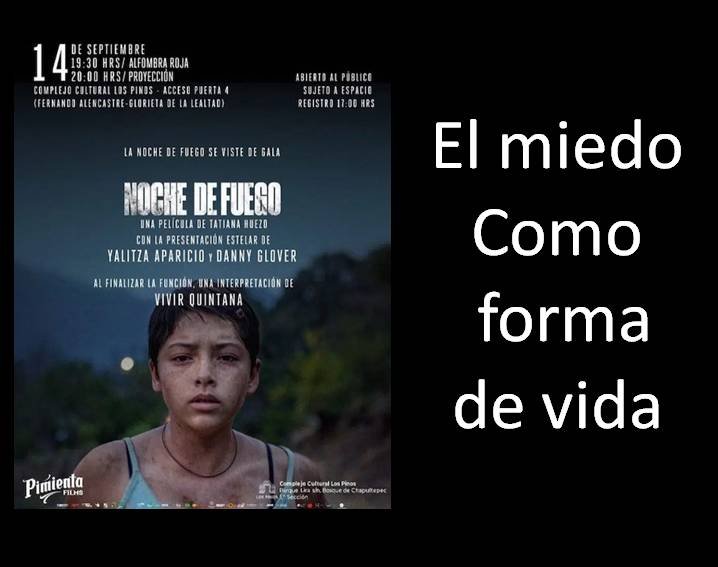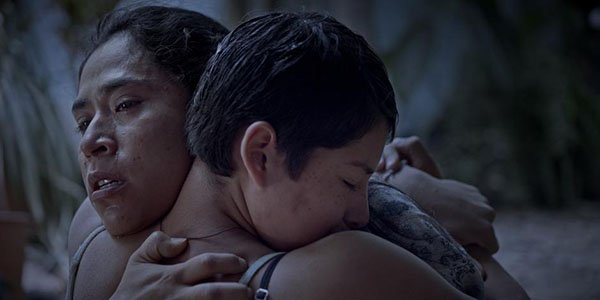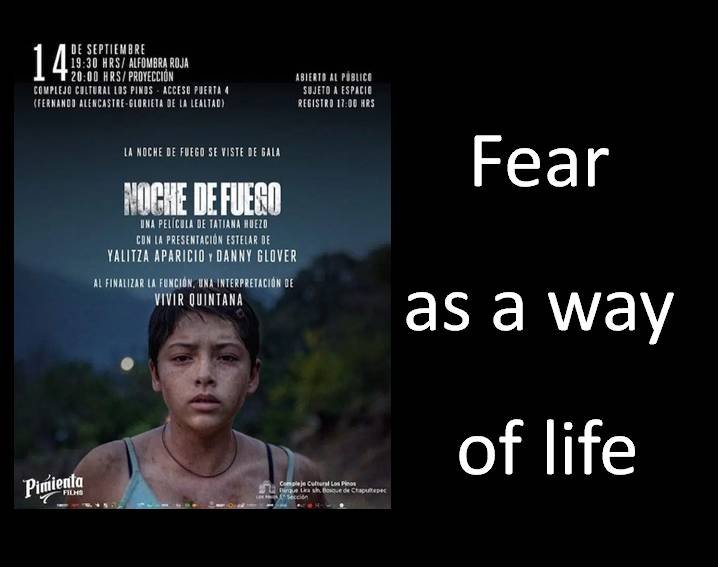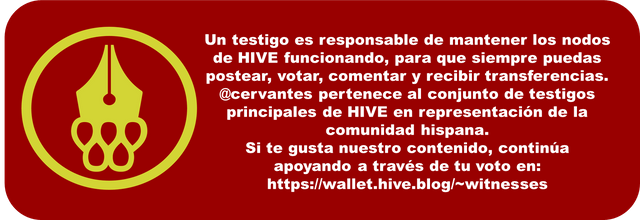Noche de Fuego//Night of Fire [ESP-ING]

Cuando me decido ver una película del género drama, una vocecita interior me dice: agárrate duro para que no te tambalees porque hay cosas en la vida de cada persona que pueden ser muy dramáticas y al sumergirte en esa vivencia, por muy película que sea, las emociones te envuelven e inevitablemente tomas partido en la trama.
Ahora, cuando el drama es colectivo y aunque, no tenga el rotulo “basado en hechos reales” sabemos que existe esa realidad, que hay personas, comunidades, países donde el miedo es una forma de vida, quedas completamente desprotegida y las emociones emergen sin contemplación.
Noche de fuego entra en este segundo grupo, Tatiana Huezo escritora y directora del film nos presenta el drama que viven niñas y mujeres de una comunidad rural mexicana donde el miedo, como emoción más primitiva es lo que hace posible la sobrevivencia.
La trama

Noche de fuego centra su trama en la vivencia de tres niñas en sus pasos hacia la adolescencia. Unas vidas que transcurren en un medio rural anclado en las altas montañas mexicanas, dominada por un cartel de drogas.
Ana es una niña de aproximadamente 9 años (Ana Cristina Ordóñez, Ana niña) parte de su día a día es ir a la escuela y jugar con sus dos amigas: María (Blanca Itzel Pérez. María niña) y Paula (Camila Gaal. Paula niña), las tres saben que algo sucede en la comunidad pero en su corta edad no logran comprender la magnitud del peligro.
Ana, vive con su madre, Rita, (Mayra Batalla), en medio de una gran pobreza material. Pasan sus días esperando el regreso del padre-esposo. Mientras tanto, Rita se esfuerza en proteger a Ana. Al ritmo, aparentemente lento, que puede dar la cotidianidad, se van desplegando las vivencias que dan contexto.
Es una población de niños, mujeres y ancianos, los hombres jóvenes han emigrado a las ciudades buscando otras fuentes de ingresos, las mujeres en las noches parecen luciérnagas con sus teléfonos encendidos buscando una señal para establecer comunicación, el cartel domina al pueblo, los agentes del orden público se esconden cuando estos llegan, los maestros ya no quieren ir al pueblo porque no tienen ninguna garantía de sus vidas, las mujeres buscando proteger a sus familias y medios de subsistencia trabajan para el cartel en las plantaciones de amapola. Rita poco a poco ha ido enseñando a Ana a escuchar, a cerrar los ojos e identificar los sonidos que la pueden salvar.
Ya las tres niñas son adolescentes y como tales tienen sus sueños e ilusiones juveniles, con sus 12 o 13 años son más conscientes de su realidad, se apoyan y protegen, también conocen del miedo, del esconderse, del huir como animales que son asechados, sin embargo, Ana no termina de entender a su mamá, su resistencia a ayudar a los otros, a involucrarse y hacer frente a lo que sucede.
Tras unos eventos dolorosos Rita, Ana y un grupo de personas de la comunidad toman la decisión que consideran como única y válida para sobrevivir.
Comentario intencionado

Tatiana Huezo hace una semblanza que no es ajena a ningún país latinoamericano. La droga como eje que dinamiza economías locales e incluso nacionales es palpable y con ella llegan el poder y el sometimiento de comunidades completas.
En su narración fílmica, realmente dramática, nos expone la violencia de género contra niñas y mujeres que son victimizadas e invisibilizadas en una lucha social acercándose a la denuncia.
Una de los aspectos que más resaltan es la sororidad que nace entre las mujeres del pueblo, se apoyan mutuamente para proteger a las hijas de un destino que parece inevitable. A través de la trama la directora nos hace un llamado a la intervención a no ser solo observadores horrorizados de una situación que afecta a muchos. Con una frase contundente de Ana nos reta: —¿Te gustaría que te pasara a ti?
No hay distractores, cada escena tiene su razón de ser para formar el cuadro total. Las actuaciones, primero de las niñas y posteriormente de las adolescentes son impecables cada una asume su rol con extrema madurez y sensibilidad. Rita es la madre que ama, capaz de hacer cualquier cosa por proteger a su hija, con las debilidades que pueden producir la incertidumbre y la soledad pero siempre sobreponiéndose ante los retos.
Con una excelente fotografía intimista que escudriña detalles intuimos, no hay escenas de alta violencia, no hay sangre, es una violencia brutal percibida por cada uno de los sentidos, envolvente que crea una tensión de inicio a fin explorando emociones que detrás de ellas solo hay una que define el acontecer de la vida: el miedo.
Noche de fuego ha sido nominada al Óscar y en Cannes fue largamente aplaudida, yo con mi mirada intencionada, sin dudar le otorgaría el gran premio.

In English

When I decide to watch a movie of the drama genre, a little inner voice tells me: hold on tight so you don't stagger because there are things in the life of each person that can be very dramatic and when you immerse yourself in that experience, no matter how much movie it is, the emotions surround you and you inevitably take sides in the plot.
Now, when the drama is collective and although it does not have the label "based on real events" we know that this reality exists, that there are people, communities, countries where fear is a way of life, you are completely unprotected and emotions emerge without contemplation.
Tatiana Huezo, writer and director of the film, presents us with the drama experienced by girls and women in a rural Mexican community where fear, as the most primitive emotion, is what makes survival possible.
The Plot

Noche de fuego focuses its plot on the lives of three girls on their way to adolescence. Their lives take place in a rural environment anchored in the high Mexican mountains, dominated by a drug cartel.
Ana is a girl of approximately 9 years old (Ana Cristina Ordóñez, Ana girl) part of her daily life is going to school and playing with her two friends: María (Blanca Itzel Pérez. María girl) and Paula (Camila Gaal. Paula girl), the three of them know that something is happening in the community but at their young age they are unable to understand the magnitude of the danger.
Ana, lives with her mother, Rita, (Mayra Batalla), in the midst of great material poverty. They spend their days waiting for the return of their father-husband. Meanwhile, Rita strives to protect Ana. At the seemingly slow pace that everyday life can give, the experiences that provide context unfold.
It is a town of children, women and the elderly, the young men have migrated to the cities looking for other sources of income, the women at night look like fireflies with their phones on looking for a signal to establish communication, the cartel dominates the town, the law enforcement agents hide when they arrive, the teachers no longer want to go to the town because they have no guarantee of their lives, the women seeking to protect their families and livelihoods work for the cartel in the poppy plantations. Rita has gradually taught Ana to listen, to close her eyes and identify the sounds that can save her.
The three girls are already teenagers and as such they have their youthful dreams and illusions, with their 12 or 13 years they are more aware of their reality, they support and protect themselves, they also know about fear, hiding, fleeing like animals that are stalked, however, Ana does not quite understand her mother, her resistance to help others, to get involved and to face what is happening.
After some painful events, Rita, Ana and a group of people from the community make the decision they consider the only valid way to survive.
Intentional Commentary

Tatiana Huezo makes a portrait that is not alien to any Latin American country. Drugs as an axis that dynamizes local and even national economies is palpable and with it comes power and the subjugation of entire communities.
In his filmic narration, truly dramatic, he exposes gender violence against girls and women who are victimized and made invisible in a social struggle approaching denunciation.
One of the aspects that stand out the most is the sorority that is born among the women of the village, who support each other to protect their daughters from a fate that seems inevitable. Throughout the plot, the director calls us to intervene and not just be horrified observers of a situation that affects many. With a forceful phrase from Ana she challenges us: -Would you like it to happen to you?
There are no distractors, each scene has its reason for being to form the total picture. The performances, first by the girls and later by the teenagers, are impeccable, each one assumes her role with extreme maturity and sensitivity. Rita is the loving mother, capable of doing anything to protect her daughter, with the weaknesses that uncertainty and loneliness can produce, but always overcoming challenges.
With an excellent intimate photography that scrutinizes intuitive details, there are no scenes of high violence, there is no blood, it is a brutal violence perceived by each of the senses, enveloping that creates a tension from start to finish exploring emotions that behind them there is only one that defines the events of life: fear.
Night of Fire has been nominated for an Oscar and in Cannes it was applauded for a long time, I with my intent look, I would without hesitation award him the grand prize.
Translated with www.DeepL.com/Translator (free version)
Fuente de imágenes: Portada - 1 - 2




MIS REDES SOCIALES





Te invito a apoyar este proyecto como witnes y a formar parte de esta gran comunidad uniéndote a su Discord en el siguiente enlace:
Discord de la comunidad Cervantes




https://twitter.com/damaryspacheco5/status/1483085052045144066
The rewards earned on this comment will go directly to the person sharing the post on Twitter as long as they are registered with @poshtoken. Sign up at https://hiveposh.com.
Me agradan estas recomendaciones atractivas, además tu reseña es impecable. Me gustará verla.
Saludos amiga.
Un abrazo desde acá
Hola @slwzl es una película cruda y dolorosa que sensibiliza al extremo, espero que la veas y comentes. Saludos.
This looks like something that needs to be on people's watchlist and the subtitle is neatly done as can be seen from the trailer you dropped for us. That trailer was very captivating.
The struggle to survive is very tough on everyone but it gets worse when you are in a place where a lot of irregular social activities are going on. Surviving in a place where drug dealers rule is one of the toughest.
Our Latin American countries, human rights are frequently and easily violated, everyone who gives voice to these situations must recognize and support them, as is the case in this film.
Thanks for coming and commenting.